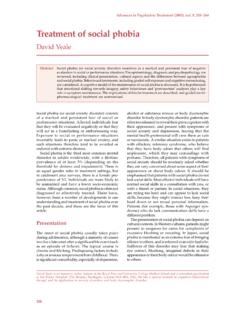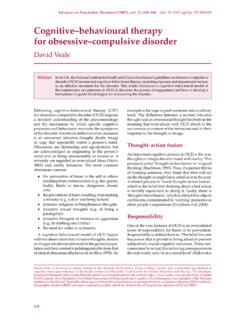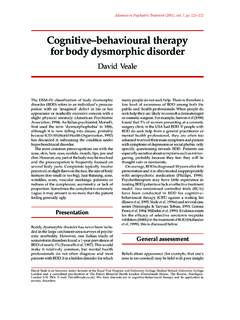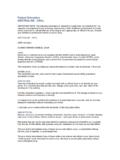Transcription of Cognitive behaviour therapy for a specific phobia of vomiting
1 EDUCATION ANDSUPERVISIONThe Cognitive behaviour Therapist, 2009,2, 272 288 behaviour therapy for a specific phobia of vomitingDavid Veale NIHR Specialist Biomedical Research Centre for Mental Health at the South London and Maudsley NHSF oundation Trust and The Institute of Psychiatry, King s College London, UKReceived 30 November 2008; Accepted 9 September 2009; First published online 22 October article summarizes the current knowledge and treatment for a specificphobia of vomiting (SPOV). It is relatively uncommon compared to other specificphobias but may have been misdiagnosed in catchment-area surveys. The differentialdiagnosis of SPOV includes obsessive compulsive disorder, hypochondriacal disorderand anorexia nervosa. I discuss the following: a model that is linked to past aversiveexperiences of vomiting ; conducting a clinical assessment; making a formulation;psycho-education, engagement and therapy .
2 The strategies employed depend on theformulation but are likely to include: exposurein vivoto cues of vomiting , exposure inimagination and role-plays of vomiting , imagery re-scripting, behavioural experiments;and dropping of safety-seeking words: Cognitive behaviour therapy , exposure, specific phobia , specific phobia of vomiting (SPOV) has been a neglected area of research. Epidemiologicalstudies suggest that the prevalence of specific phobiasin generalis extremely common witha 12-month prevalence of about 7 13% (Boydet ; Kessleret ; Beckeret ; Stinsonet ). Of these, only one study specifically enquired about a phobia ofvomiting which had a prevalence of (Beckeret ). The study by Stinsonet al.(2007) found the numbers of SPOV too small to analyse (Grant, personal communicationin Stinsonet ). These estimates are in sharp contrast to the estimates suggested byKirkpatrick & Berg (1981, cited in Philips, 1985) and van Hout & Bouman (unpublishedobservations cited in van Overveldet ) who claim a prevalence of for malesand 6 7% for females.
3 However, these studies are based on afear of vomitingrather thandiagnostic criteria for is significant overlap in SPOV especially with health anxiety and obsessive compulsive disorder, for which it may have been misdiagnosed in some of the surveys. Despitebeing uncommon, clinicians generally regard SPOV as more difficult to treat and different inpsychopathology compared to other specific phobias . For example, people with SPOV tend tobe more handicapped than people with other specific phobias ( avoidance of a desired preg-nancy or being significantly underweight from restriction of food; Manassis & Kalman, 1990). Author for correspondence: Dr D. Veale, Centre for Anxiety Disorders and Trauma, 99 Denmark Hill, London SE58AZ, UK (email: British Association for Behavioural and Cognitive Psychotherapies 2009 Specific phobia of vomiting273 Characteristics of SPOVL ipsitzet al.(2001) and Veale & Lambrou (2006) have published surveys of people with aSPOV from internet support groups.)
4 These studies suggest it commonly develops in childhoodwith a mean duration of about 25 years and occurs almost exclusively in women (for thisreason I will refer to clients in the female gender). The gender differences may be reflected inthe normal population men may be more likely to view vomiting as a joke and even desire tovomit after heavy drinking. Most people with a SPOV are predominantly fearful of their self- vomiting (Veale & Lambrou, 2006). They may also strenuously try to avoid people who theybelieve to be at risk of vomiting usually because they believe it would put themselves at risk ofvomiting. Even if there is no evidence that a person vomiting is contagious, such individuals area stimulus for having to think about vomiting or feeling nauseous and a client may then believethat it would cause her to vomit by a process of magical thinking. A minority of people withSPOV are either exclusively or predominantly fearful of others vomiting (usually on them), asdescribed by McKenzie (1994) and McFadyen & Wyness (1983).
5 This might be described as asubtype of SPOV or a different specific phobia . These people may be easier to treat and shouldbe investigated separately in any controlled trial. The rest of this article therefore assumes thata client is predominantly fearful of herself vomiting (or of herself and others equally).Davidsonet al.(2008) have highlighted the relationship between a heightened internallocus of control and a SPOV. This is in keeping with the experience of people with SPOVwho fear losing control and who may convince themselves that they can avoid vomiting bycontrolling a reflex response. Van Overveldet al.(2008) found that people with SPOV haveincreased levels of disgust propensity and sensitivity and that this is the best predictor ofsymptoms in SPOV. Boschen (2007) discussed a Cognitive behavioural model and researchagenda. He described how people with SPOV may be more vulnerable to general anxietyand somatization (a tendency to express anxiety through somatic symptoms specificallygastrointestinal symptoms, nausea, bloating, diarrhoea, butterflies ).
6 They may havesuffered aversive experiences of themselves and others extreme anxiety, some people (especially children) may vomit probably through theparasympathetic vagal pathway which can also lead to immobility, fainting, dissociation anddefecation (Porges, 2007). The experience of vomiting as a child might be associated withthe feeling of suffocation or death and be a factor in the development of SPOV. Ohman &Mineka (2001) suggest that a fear module is preferentially activated in aversive contexts bystimuli that are fear relevant in an evolutionary perspective. This can include food aversionsthat have developed after vomiting and could lead to avoidance of cues related to vomiting (Garciaet ). Such aversions are extremely enduring and this is a probable factor inthe development of a SPOV. Ohman & Mineka (2001) also suggest that activation to suchstimuli is automatic and is relatively impenetrable to Cognitive control.
7 They suggest that afear module mediates an emotional level of fear learning that is relatively independent anddissociable from Cognitive learning of stimulus SPOV is relatively easy to diagnose when a client presents with a fear of vomiting . The keycriteria for a specific phobia in DSM-IV (APA, 2000) are given in Table 1. The words in italicsabout vomiting have been added to the relevant criteria. DSM-IV classifies SPOV as SpecificPhobia Other type which may have the unintended effect of minimizing research into SPOV(Boschen, 2007).274D. VealeTable criteria for specific phobia of vomiting (a) Marked and persistent fearof vomitingthat is excessive or unreasonable, cued by the presence ofvomitor anticipationof vomiting .(b) Exposureto cues related to vomitingalmost invariably provokes an immediate anxiety response,which may take the form of a situationally bound or situationally pre-disposed panic attack.
8 (c) The person recognizes that the fearof vomitingis excessive or unreasonable.(d) Phobic situationsrelated to vomitingare avoided or else endured with intense anxiety or distress.(e) The avoidance, anxious anticipation, or distress interferes significantly with the person s normalroutine, occupational (or academic) functioning, or social activities or relationships, or there ismarked distress about having the first discuss the differential diagnosis of SPOV from other anxiety disorders and anorexianervosa and how they may be comorbid. It is particularly important to note the onset of acomorbid diagnosis and its functional relationship to disorder(health anxiety)People with hypochondriacal disorder are concerned with the fear of being ill (in which thefocus of a disease often varies over time) rather than vomitingper se. People with SPOV often have a significant degree of health anxiety in that they worry about infections or foodpoisoning that may cause them to vomit.
9 Alternatively, they attribute the cause of nausea toa physical problem ( irritable bowel syndrome, or middle ear disease) rather than diagnosis of a comorbid hypochondriacal disorder would be made if there were additionalfears of illness unrelated to compulsive disorder(OCD)People with SPOV often perform rituals or superstitious behaviours to prevent vomiting andthese tend to develop after the SPOV. A comorbid diagnosis of OCD would be made if therewere additional obsessions and compulsions that are unrelated to rituals and an over-inflatedsense of influence over their ability to stop themselves or others disorderA diagnosis of panic disorder requires recurrent unexpected panic attacks with anticipatoryanxiety about further attacks. Sometimes the main fear of panic disorder is of vomiting whenfeeling nauseous and anxious (but this is usually in the context of other physiological sensationsand minimal avoidance of cues relating to vomiting ).
10 It is, however, still possible to have anadditional comorbid spontaneous panic attacks unrelated to a phobiaThe majority of people with a SPOV are fearful of vomiting whether they are alone or in socialsituations (often equally). The embarrassment of vomiting in public may be an additionalburden for a person with a SPOV. Here the fear of others being critical of vomiting in publicSpecific phobia of vomiting275may require extra focus in therapy . People who are predominantly fearful of the embarrassmentof vomiting in public situations (and are not especially fearful of vomiting when they are alone)would have a diagnosis of social phobia . Such a case is described by Lesage & Lamontagne(1985). McNally (1997) also describes an atypical social phobic who would induce vomitingif she had to leave her home unexpectedly and before she had fully digested a meal. Thusvomiting in the privacy of her home was better than her negative evaluation of vomiting specific phobiasThe fear of choking or suffocating on vomit may be a secondary problem in SPOV.









